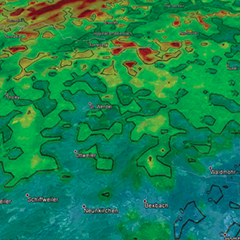EWC Weather Consult’s high-speed computing graphic cards reduce uncertainty in long-term performance reference and the prediction of wind power production.
Today, meteorologists need high-performance computing architectures in order to create high-quality weather forecasts and analyses. These results play a key role in the evaluation, production, provision and trade of wind power. It is now time to highlight these computing architectures which are the key to progress of wind power. In the Karlsruhe Technology Region, located in southern Germany, we have discovered an innovative weather service provider. As a pioneer in the optimisation of weather data, EWC’s range of services goes far beyond merely using state-of-the-art computing concepts.
“It is important to know that today numerical weather models are used for more than just forecasts. Instead, they are also simulating the three-dimensional atmosphere in the past”, explains Dr. Achim Strunk, Head of Energy Division at EWC Weather Consult. “The available historical measurement data from the last 35 years is used in order to generate predictions of the atmosphere in the historic context which are constantly adapted to the current measurement data. The results are valuable re-analyses which can provide the wind power industry with hourly wind time series at hub height.” This is a pleasing prospect for site assessments since establishing the long-term reference at site level has so far been very difficult.
Know precisely the potential of a site
The Karlsruhe weather experts are using these re-analyses to reduce the uncertainty of yield forecasts as compared to customary processes. Everybody involved with wind power will welcome improvements, especially in the calculation of the financing-relevant P90 – the yield of a wind park that is achieved in nine of ten years during a financing period.
EWC uses the 3D data of the North American MERRA re-analyses and calculates the wind time series at measurement heights using the processes which will be described below. However, these time series reveal systematic and non-systematic errors and must be adapted to the local circumstances using wind measurement.
This met mast data is the basis for determining the systematic of errors/biases in an overlapping time period. The procedures are trained and this newly-acquired correction of the deviations is then applied to the other periods of the wind time series. Thus the result is an hourly virtual measurement time series which at EWC includes nearly 35 years and which show only marginal deviations from the original measurements.
These methods of long-term correction (Measure Correlate Predict, MCP) are generally part of site assessments. They usually allow linear corrections such as the sector-based MCP using linear regressions. Some newer MCPs can even formulate non-linear corrections. For example, the matrix method places its focal point on the most correct mapping of the frequency distribution of the wind speeds.




























